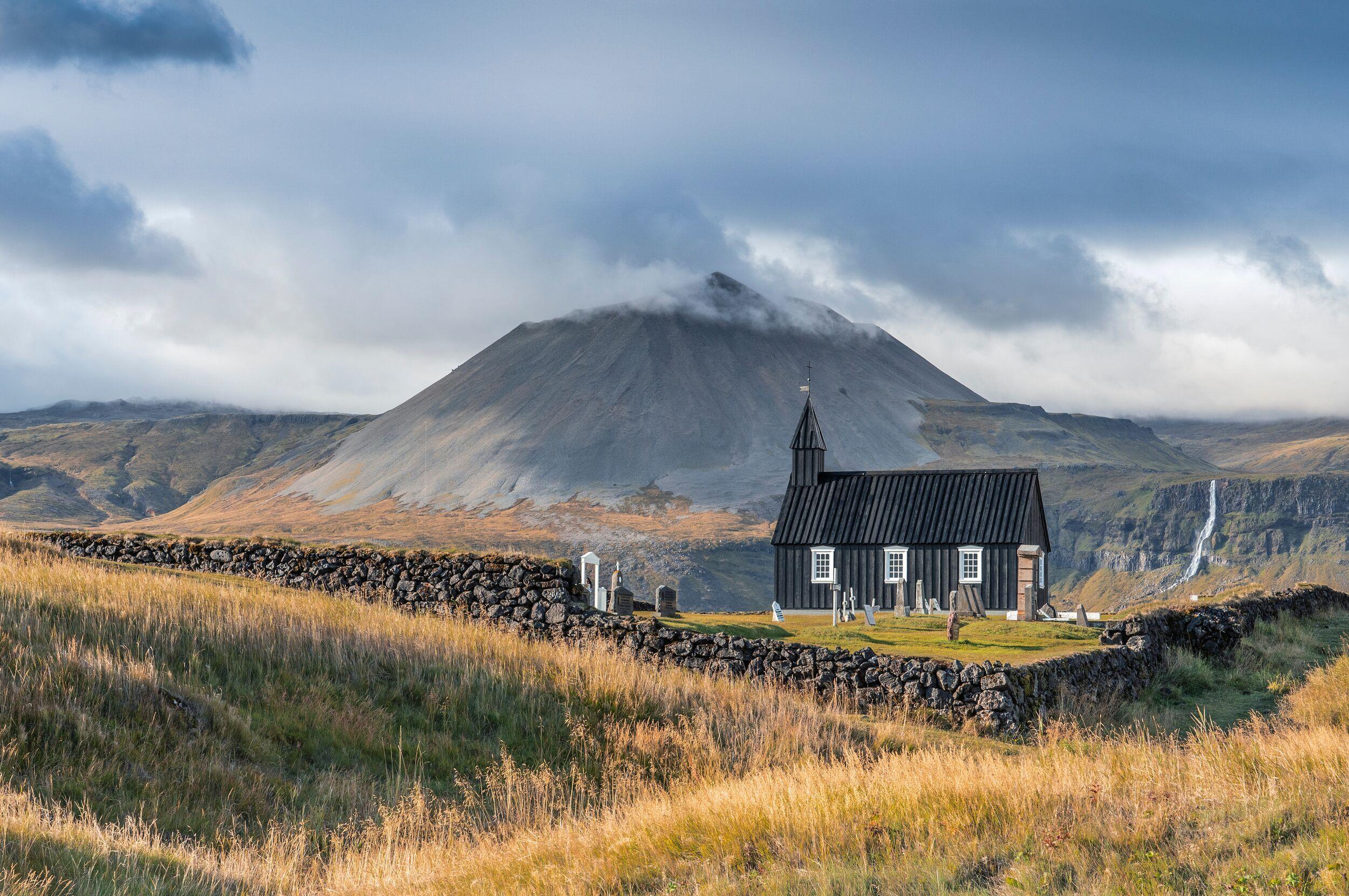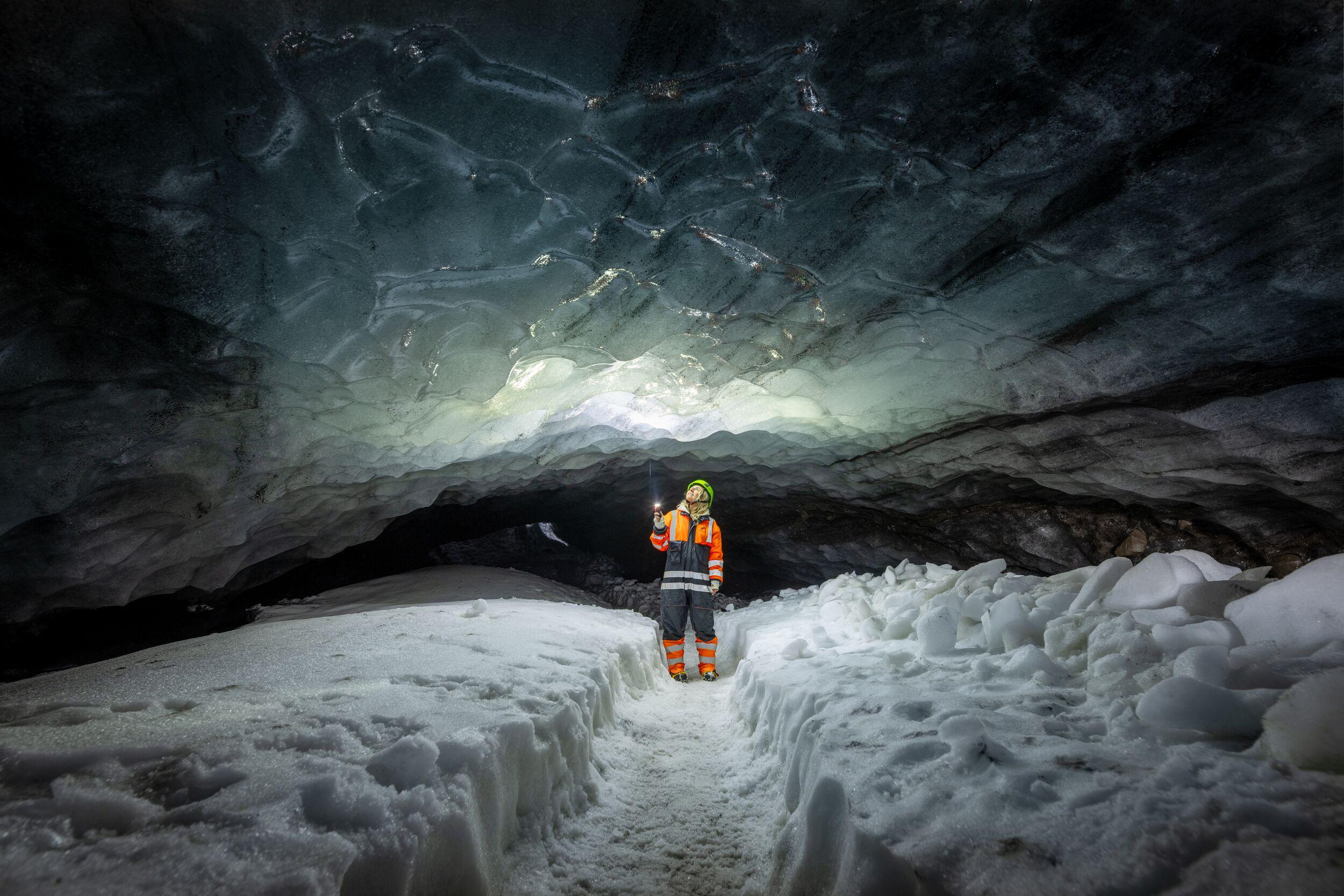Your Ultimate Guide to Hiking in Iceland
Table of Contents
- 1Why Should You Hike in Iceland?
- 2The Best Day Hikes in Iceland
- 3Moderately Challenging Hikes
- 4Epic Multi-Day Hikes: The Laugavegur
- 5Fimmvörðuháls (Þórsmörk)
- 6Other Recommended Multi-Day Treks
- 7Hiking Fagradalsfjall Volcano and the Eruption Sites
- 8Guided Glacier Hikes
- 9Seasonal Considerations
- 10Getting to Grips with Iceland’s Unique Weather Conditions
- 11How to Be Fully Prepared for Hiking in Iceland
- 12The Benefits of Exploring Iceland's Trails with Guides who Prioritise Safety
- 13Staying Safe During a Glacier Hike
- 14How Hikers Should Treat Iceland’s Fragile Environment
- 15Questions and Answers about Hikinh in Iceland
Why Should You Hike in Iceland?
Hiking is a multi-sensory experience in a way travelling by bus or car could never be. Though most sightseeing tours involve a little walking, they often proceed at a relatively quick pace. That’s no bad thing, of course, as Iceland’s many scenic highlights deserve a share of the limelight. But there’s something magical about taking a deeper dive into the countryside and immersing yourself in nature.
It’s not just the crunch of gravel under your boots as you embark on the trail or the fresh air pricking your cheeks as it creates a rosy glow. It’s not even the sound of trickling water or the distant baaing of ewes chastising wayward lambs. It’s something more holistic: the enveloping calm of being surrounded by nature, the sense of timelessness as you gaze out at an untouched valley and the feeling of peace and tranquillity that accompanies the knowledge that you’re merely a small cog in a very big machine.
The Best Day Hikes in Iceland
You don’t have to spare much time out of your schedule if you want to go hiking in Iceland. There are plenty of delightful walks that can be achieved in a day or less.
While hiking alone is free, save perhaps for a car parking charge, it pays to engage a private guide or join a group tour to get the best out of your hike. As they are easily accessible from Reykjavik, Iceland’s South Coast and Golden Circle regions are a good place to start, but there are delightful hiking trails to be found in every part of the country.
Easy strolls for all the family
Iceland’s hiking trails start as short strolls suitable for even the youngest members of the family.
- For example, during a tour of the Golden Circle, a stroll through the steep-sided Almannagjá Gorge within the oldest of Iceland’s national parks, Thingvellir, is a treat for anyone with an interest in geology. The reward, a couple of kilometres along the path, is pretty Öxarárfoss waterfall.
- Also within easy reach of the capital is a hike through Mosfellsdalur. A loop trail begins and ends at Mosfellskirkja, ascending steadily to Mosfell from where you can enjoy a great view of Mount Esja. Allow a couple of hours to complete this 4km hike.
- On the Snæfellsnes Peninsula, it will only take an hour or so to walk from Arnarstapi to Hellnar but the coastal scenery is among the most striking in the country.
- Iceland’s waterfalls are the setting for other hikes with the wow factor. Skógafoss is a popular stop on many South Coast tours; with more time at this location, a path leads inland, hugging the Skógá River and its numerous smaller falls.
- Meanwhile, in Skaftafell, a path leads uphill to dramatic Svartifoss, where basalt columns flank a towering single-drop cascade.
- Geothermal activity is common throughout much of Iceland. One of the most memorable hikes to exploit this aspect of the country’s makeup is that which leads to the hot water river at Reykjadalur. Allow two hours each way plus time for a soak.
- Trails also loop around Hverir in the Mývatn area of north east Iceland; stick to the paths to avoid the scalding hot water as you skirt around its plumes of steam.
Moderately Challenging Hikes
- Our Glacier Panorama Trail hike unlocks the breathtaking scenery around Katla, historically one of Iceland’s most active (but currently dormant) volcanoes. Fabulous views of Eyjafjallajökull and Sólheimajökull are just two of the many highlights of this mostly downhill trek. You’ll cover the scenic 9km at a comfortable pace.
Mountain summits that can be conquered in a single day
- Hike to the summit of Snæfellsjökull, a dormant stratovolcano shrouded by a sizeable glacier. It’s a tough climb, but the ocean and peninsula views from the peak are breathtaking.
- Alternatively, summit Iceland’s highest peak, Hvannadalshnúkur 2110 metres above sea level. You’ll need climbing experience to conquer this demanding peak, but again, the panoramic view for those who make it to the top is extraordinary.
Epic Multi-Day Hikes: The Laugavegur
Some of the best hikes in Iceland are also the longest. Laugavegur and Fimmvörduháls are the standouts in a country with so mait is moderately challenging and requires a reasonable level of fitness but no exceptional technical skill. The path is well signed and should take most walkers around four days to complete,ny fabulous long-distance routes. Tackle them separately or combine the two for an even more magical experience.
Laugavegur Trail
The Laugavegur trek is a world-class hike that extends for 55 km. Probably the most famous hike in the country, you’ll face a moderately challenging trail that requires a reasonable level of fitness but no exceptional technical skill.
The path is well signed and should take most walkers around four days to complete assuming they’re on their feet for between four and seven hours a day. The route rises and falls through some of Iceland’s most impressive volcanic scenery, beginning at geothermally active Landmannalaugar.
Breathtaking lava fields the colour of charcoal draw the eye to rhyolite mountains riddled with minerals. You’ll amble past steamy vents and bubbling hot springs, walk amid moss-covered landscapes and gaze out at snow-capped peaks. Eventually, you’ll reach the birch forest of verdant Þórsmörk.
Those with a sense of adventure will revel in this untamed terrain, taking river crossings in their capable stride and completing this epic hike with a sense of accomplishment. Mountain huts and campsites along the way provide welcome pit stops where you can unwind and process the day’s activities.
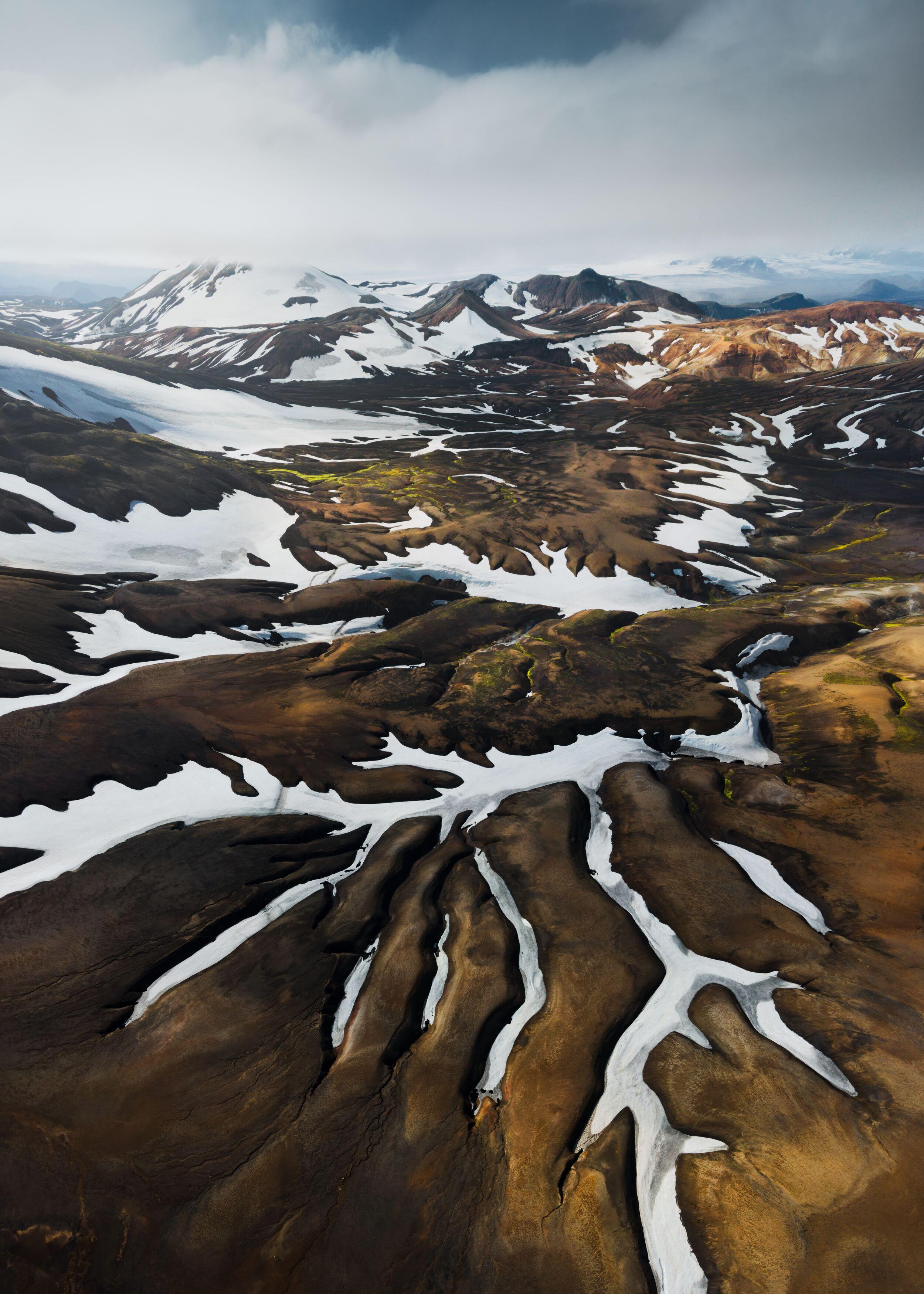
The Laugevegur & Fimmvörduháls trail was listed among the Top 25 hikes in the world by National Geographic
Fimmvörðuháls (Þórsmörk)
Fimmvörðuháls connects the Þórsmörk valley to Skógafoss, an impressive waterfall which overlooks Iceland’s south coast. It’s significantly shorter than the Laugavegur trek, measuring 25km from end to end. Fit and experienced hikers can complete this trail within a single day, though it’s more common to stretch it out over two. We suggest allowing around 9-12 hours to complete this hike.
Some argue that this is the most beautiful hike in Iceland, and its varied scenery certainly makes it a strong contender. The riverside trail follows a string of waterfalls inland before crossing a barren lava field. Witness the Magni and Modi craters formed during the 2010 eruption. It snakes between two of South Iceland’s best-known glaciers, Eyjafjallajökull and Mýrdalsjökull, before dropping down to the River Krossá in Þórsmörk.
But while the weather can be calm and sunny at either end of the trail, up there along the highest parts, the conditions can quickly turn brutal. Snow and rain can lash hikers, and ferocious winds can batter them. Fog is also common, so if you are hoping to complete this trail, don’t underestimate how dangerous it can be, even in summer.
Other Recommended Multi-Day Treks
Askja: 97km, 5 days
- In the north of Iceland, the Askja trail leads over a vast lava field to the nested calderas of Askja, a remote yet active volcano.
Kjölur the old: 41km, 2-3 days
- From the geothermal hot springs of Hveravellir, this trail climbs between Langjökull and Hofsjökull. The stellar scenery includes flower-strewn meadows and glacial lakes.
Hornstrandir: 86km, 6 days
- Remote even by the standards of the Westfjords, Hornstrandir is a protected nature reserve. Hikers exploring this uninhabited wilderness will appreciate fjord views and wildlife.
Borgarfjörður Eystri to Seyðisfjörður: 55km, 3-4 days
- East Iceland’s fjords are a stellar location for hikers. In summer, leave the puffins behind at Borgarfjörður Eystri to follow the path to the charming port of Seyðisfjörður.
Vatnajökull National Park: 90km, 7 days
- Our Volcanic Trails tour promises an unrivalled experience in the largest of Iceland’s national parks. Waterfalls, canyons, moss-covered lava and black sand are all highlights.
The Icelandic Highlands, one of the largest wilderness areas in Europe, cover about 40% of Iceland's land area. This vast and uninhabited plateau features volcanic deserts, geothermal areas, glaciers, and stunning mountain ranges, and is accessible to hikers only between late June and early September.
Hiking Fagradalsfjall Volcano and the Eruption Sites
When magma first broke through the surface of the Reykjanes peninsula back in 2021, it came as a bit of a shock. The last time there was a volcanic eruption in this corner of Iceland was more than 800 years ago. Unsurprisingly, hikers and sightseers flocked to the area to catch a glimpse of the magma fountains and rivers of lava. As the eruption progressed, trails were hastily mapped out and then redrawn. The initial eruptions were harmless, and authorities found it safe for people to visit the eruption site.
Since then, volcanic activity has continued intermittently, with the most recent lava flows encroaching on Grindavik. However, the eruptions in 2023/24 were very different; they started intensely without any warning, causing huge cracks to form in the ground, making it unsafe to access the new eruption sites. While this part of the peninsula remains closed to visitors, the area further east around Fagradalsfjall is open.
Access to the walking trails around Mount Fagradalsfjall is now possible for those keen to inspect the previous eruption sites. It’s important to note that the Fagradalsfjall eruption site is located some 5-10 kilometres from the Sundhnjukagigar eruption area, but the whole area is quite unstable.
The authorities ask that hikers appreciate that the more recent eruption sites must remain off-limits for the time being for safety reasons and that visitors respect such closures. At the time of this writing, the hiking trails leading to Fagradalsfjall are open, but they can be closed at any time. Therefore, it’s always important for hikers to update themselves on the current conditions before setting off for a hike in the Reykjanes area.
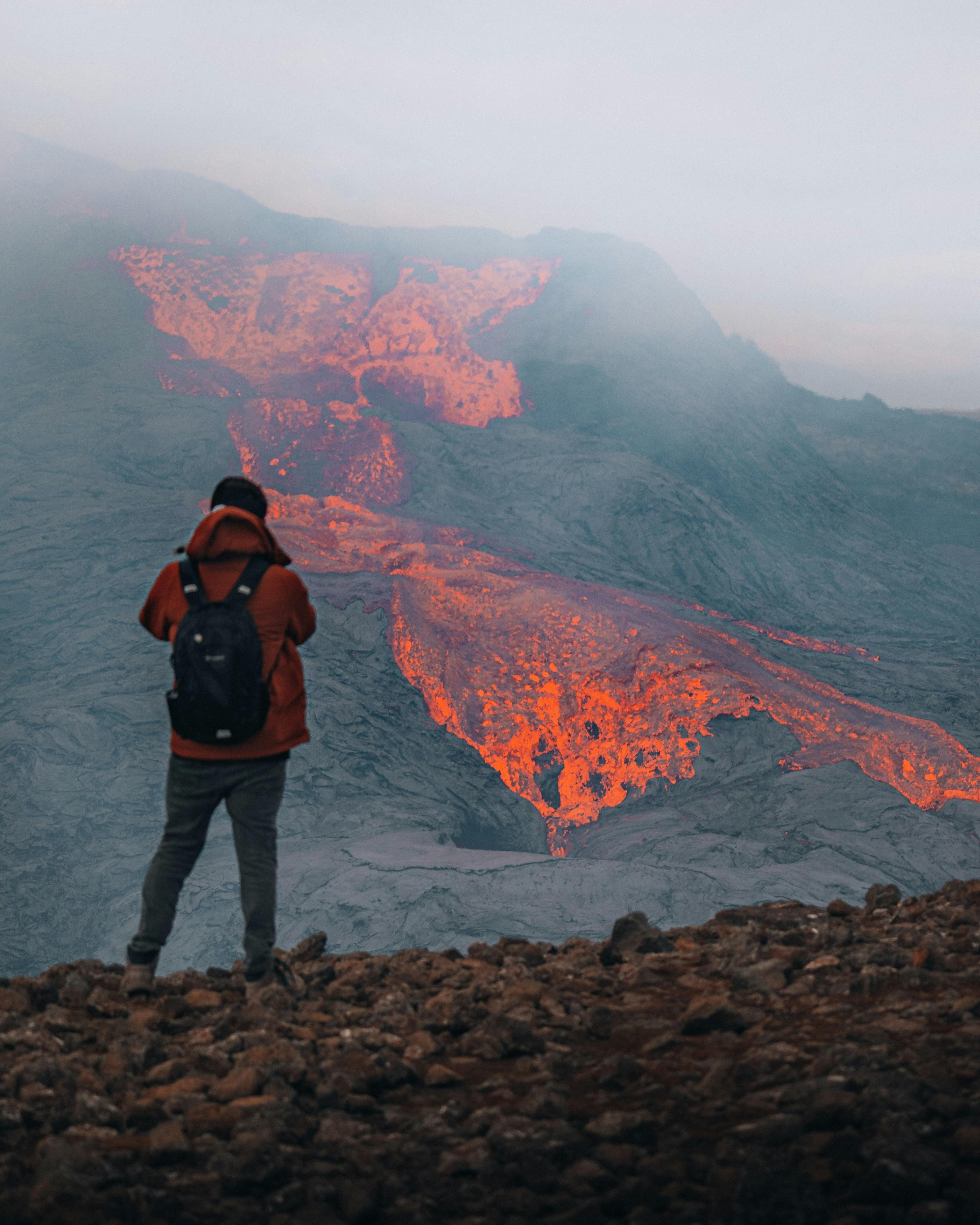
While some recent volcanic eruptions have been safe to visit, each eruption is unique. Always ensure you are well-informed and check for updates before visiting an eruption site.
Guided Glacier Hikes
If you’re planning a glacier hike in Iceland, there are plenty of guided options. Glaciers cover approximately 11% of Iceland’s land area, the largest being Vatnajökull in the southeast of the country. Outlet glaciers extend like icy tongues from the edge of Vatnajökull; they are the most accessible parts of the ice and form the focus of many glacier hikes.
Tours are varied and suitable for any ability and level of fitness.
- For instance, a short hike over the Sólheimajökull Glacier is considered an easy option, and children as young as ten can participate.
- Our Blue Ice Experience hike from Skaftafell is considered a moderate hike, though also family-friendly.
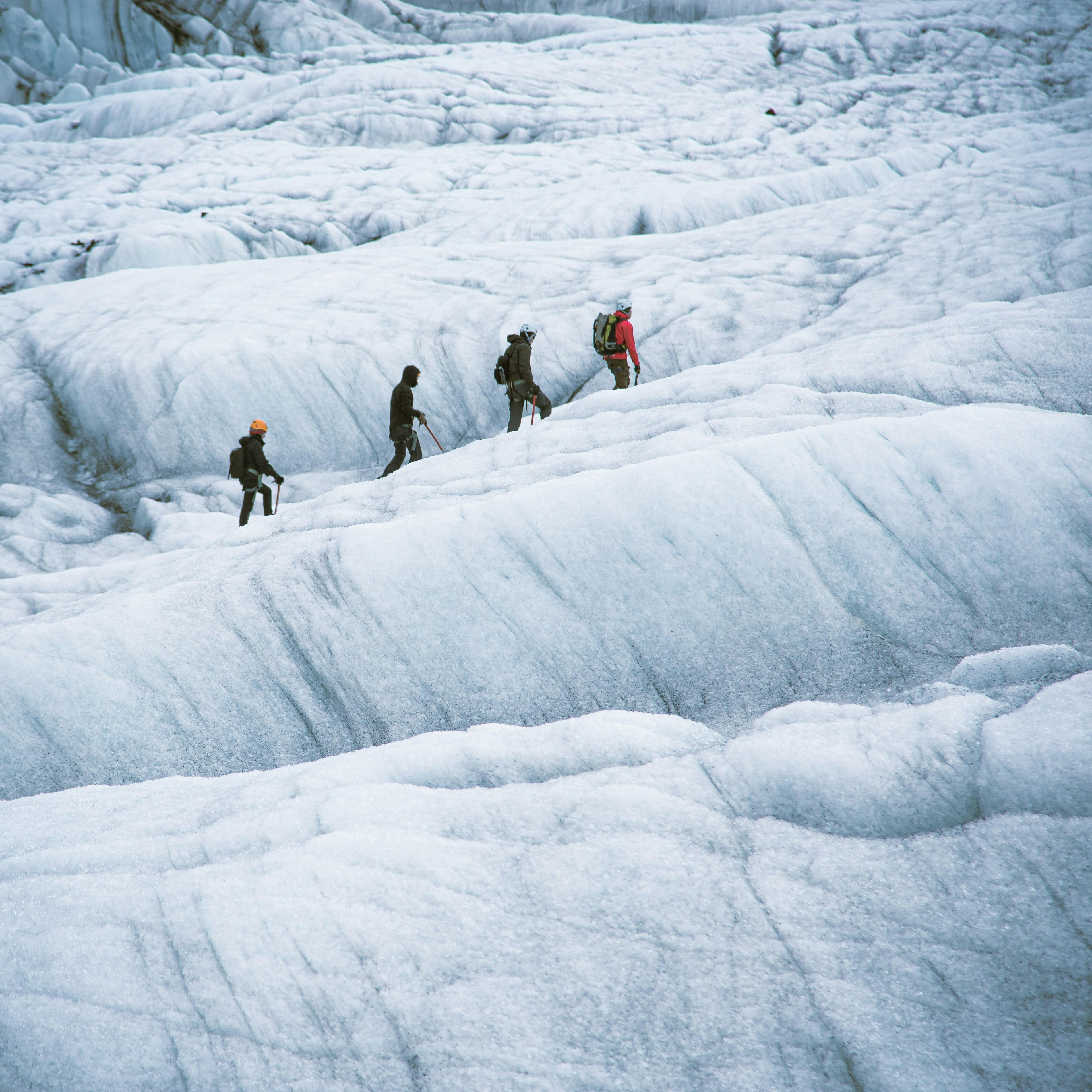
Hiking Iceland's glaciers is easy and safe when you join a guided tour. Never attempt to walk onto a glacier without a trained glacier guide.
Seasonal Considerations
Can You Hike in Iceland in Winter?
Though most hiking tours depart in summer, the answer is yes, so long as conditions permit. If you aren’t beaten by an inclement forecast or icy surfaces, off-season hikes can be rewarding. For those who are experienced mountaineers in snowy, icy conditions and are prepared with suitable gear, winter hikes can offer a unique and exhilarating experience.
Free from summer crowds, the most adventurous hikers will find solace amid Iceland’s extraordinarily scenic landscapes. Another major factor to consider, of course, is the shorter period of daylight, though even by February, this is less of a drawback than in midwinter.
However, let’s be practical. Winter brings with it an increased risk of bad weather and road closures. It’s not just seasonal routes such as the highland interior that are off-limits. From time to time, even the main ring road shuts down because of strong winds, snow, ice, or heavy downpours. Where you plan to walk is also a factor, with the north of the country statistically receiving more snow each year than the south. You might not even be able to reach the trailhead, let alone tackle the hike you planned to complete.
For those who are keen to hike in Iceland in the wintertime, we recommend staying close to Reykjavík. Believe it or not, in the backyard of the capital, you'll find some extremely rewarding hikes that are accessible throughout the winter. You might even encounter some local hikers on the trails.
Guided Offseason Hikes
The variety of guided hiking tours in Iceland increases as temperatures rise. If you’re keen to follow some of the most popular routes on offer, you might prefer to do so in the shoulder seasons of spring and autumn.
Then, the weather isn’t so harsh, the days are long enough to hike longer distances and yet you won’t find the congestion that can plague bottleneck points in the height of summer.
However, in spring, melting glaciers can leave some trails muddy and boggy while rivers swell. Autumn storms can lead to changeable weather, which brings its own challenges.
Hiking in Iceland is possible year-round, but the best experience and highest chance for a safe, enjoyable hike is between mid-June and early September.
Getting to Grips with Iceland’s Unique Weather Conditions
Iceland’s weather can be notoriously changeable, even in summer. While it can be something people joke about – if you don’t like the weather, wait five minutes is an oft-heard saying – if you’re planning to go hiking in Iceland, then it needs to be taken seriously. In extreme conditions, unprepared hikers can put themselves at risk of injury or worse.
While you’re out walking, you’ll be keen not to be soaked through. Rain, sleet, or snow showers frequently blow across the Icelandic countryside, making it essential to don effective outer layers that keep the wearer dry. A good-quality waterproof jacket, trousers, and boots are a necessity, not a luxury.
But there’s another type of weather that can be even more impactful when it comes to hiking, and that’s wind. Gusts and sustained high winds can be extremely challenging, and without shelter, hikers can be very vulnerable. Where wind speeds exceed 10 metres per second, consider whether it’s sensible to proceed; postponing a hike might be the best option in such circumstances.
It is essential to check the weather repeatedly before you set out. One of the best places to find up-to-date forecasts is the Icelandic Met Office’s website. It offers detailed information on expected temperatures, precipitation, and wind speeds for Iceland's regions. In case of mist and fog, carry a GPS device to avoid getting lost in remote areas.
Hiking in Iceland requires premium hiking gear, with a strong emphasis on wind- and waterproof layers, sturdy hiking boots, and high-quality insulation and underlayers.
How to Be Fully Prepared for Hiking in Iceland
A well-prepared hiker is a happy hiker.
- First, you’ll need a comfortable backpack, depending on the length of your hike—one that has a capacity of between 25 and 40 is about right. Also, check that the shoulder straps are padded in the right places and won’t chafe. Make sure it is roomy enough to fit a small medical kit, including any personal medications you need, sunglasses, sun cream, snacks, a water bottle, rain gear, and any spare clothing you might need to add or subtract as conditions change.
- Next: What to wear? Quick-drying gear and breathable garments that wick sweat away are ideal; heavy fabrics such as denim and thick cotton typically are not. Thermal base layers and the right socks are important—many experienced hikers swear by wool. Keeping your extremities warm is essential, so also throw in a hat and gloves that are up to the job.
- Hiking boots need a sturdy sole suitable for crossing uneven terrain have decent ankle support to protect against sprains. Hiking poles can really help with balance on steep and gravelly surfaces; many tour operators will rent them if you don’t want to bring them from home. On some hikes, but they should also, you’ll be glad you brought a swimsuit and towel, while if there’s a chance you might need to ford a stream, river shoes are a blessing.
- Safety must be your priority when hiking, especially when doing so alone. Make sure you have access to an offline map (and a power bank in case your phone battery dies); better still carry a paper copy with a plastic cover in case of rain. Carry a GPS device and/or compass, making sure you understand how they work.
- When tackling river crossings, never attempt to do so unless you are absolutely sure it’s safe. Wider sections of the river can be easier to ford than narrower stretches as they’re often shallower, and the current isn’t usually as strong. Loosen the straps of your day pack slightly so that you can shed it – and its weight – if you get into difficulty.
Most important of all, no matter how experienced a hiker you are and how well you feel you’ve prepared, is to make sure others know where you are and when to expect you elsewhere. File a copy of your planned route with Safe Travel so that rescuers know where to look for you in the event of an emergency.
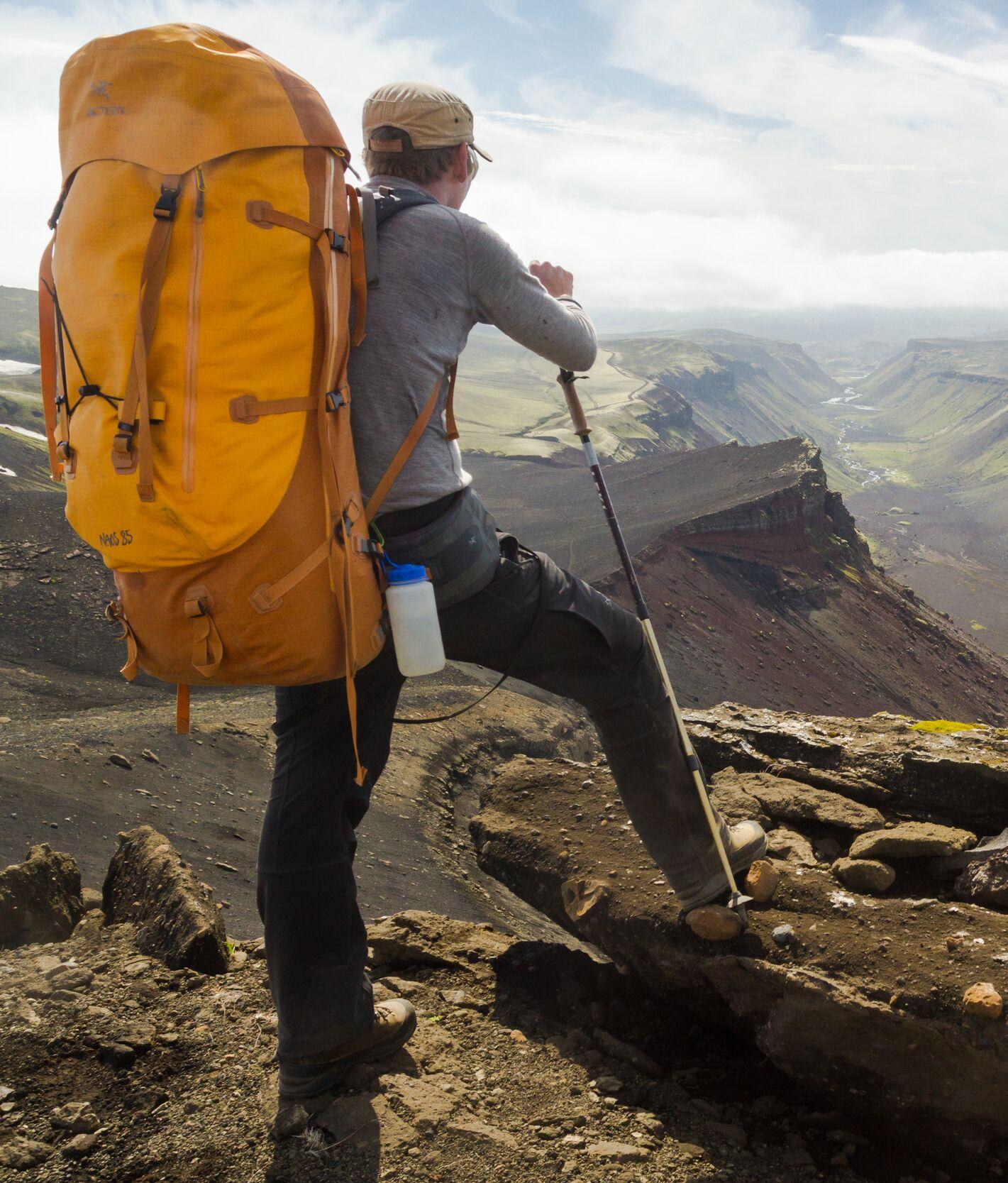
Excellent gear is essential
The Benefits of Exploring Iceland's Trails with Guides who Prioritise Safety
Given how quickly weather conditions can change, therefore, it’s sensible even for experienced hikers to consider whether they might hike with a guide. Local hiking experts have an exceptional knowledge of the landscapes in which they work and crucially spend sufficient time in them to note even subtle changes in the conditions.
It’s far easier to understand present and future conditions than it is the recent past. Resident guides will be abreast of seasonal climate patterns, rock falls, flood risks and erosional changes in a way that a casual visitor is unlikely to be, no matter how diligent their internet research and other preparations. In the unlikely event of an accident, they’ll be able to choose the best course of action to ensure speedy and effective treatment of the casualty.
But choosing to hike with a guide isn’t just about safety, important though that undoubtedly is. They also bring a wealth of knowledge to the table, adding context and insight on a range of topics including flora and fauna, geology and even folklore. Such commentary, done well, entertains as well as informs. Human interaction can elevate the enjoyment of a hike as much as solitude can.
Hiking in Iceland offers unique challenges due to its unpredictable weather, and volcanic and glacial terrains, making it sensible for even experienced hikers to consider a local guide who can provide essential safety knowledge and enrich the experience with insights on the environment and local lore.
Staying Safe During a Glacier Hike
Glaciers are dangerous places, yet their beauty lures even the most unfamiliar to gaze upon them and set foot both on and within them. Hiking on ice is very different to climbing up a mountain. For starters, a glacier is constantly in a state of flux, flexing like stiff plastic as it slips down the valley and splitting to form deep crevasses in the process.
These crevasses form one of the most significant hazards up on the ice. Snowfalls can disguise their presence, making it easy to slip into trouble. The sound of water is another red flag and can indicate that a moulin is close by. These circular, well-like shafts are formed by surface meltwater but extend far down into the glacier. Falling down one could have potentially disastrous consequences.
It’s because of landforms such as these that it’s so important to sign up for an organised, guided glacier hike rather than to go it alone. Ice caves are ethereal, magical spaces, but cave-ins can happen without obvious warning. A good guide will ensure you have the correct gear, such as crampons, ropes, ice axes and helmets, and will teach you what to look for as you explore the glacier together.
How Hikers Should Treat Iceland’s Fragile Environment
No matter where you plan to hike, you should always treat your surroundings with respect, but this adage is doubly true of Iceland’s fragile environments. It goes without saying that it’s crucial for hikers to leave no trace, which in practice means adopting good practices such as sticking to marked trails and carrying out all rubbish.
The Icelandic Nature Conservation Act protects the right of people to enjoy the Icelandic countryside but stipulates that travellers must be careful not to damage or spoil natural resources in the process. Showing consideration and being tolerant of others are key principles.
Official guidance states that the thoughtless actions of travellers can have long-term negative consequences to the country’s vegetation and geology. Iceland’s sometimes extreme weather coupled with a short growing season can mean that the landscape takes far longer to repair itself than elsewhere in the world.
There’s explicit advice for hikers. Walkers are asked not to take shortcuts that might lead them to stray onto private land or pastures. While hikers shouldn’t use lakes or rivers except where expressly permitted, the use of marked trails – even where gated – is encouraged, both for the safety of users and to protect delicate environments and wildlife. Gates should always be left closed and the area left as it was found.
We hope reading this guide has motivated you to explore Iceland’s remarkable landscapes on foot and consider one of our hiking tours. Come well-prepared and leave with good memories.
Questions and Answers about Hikinh in Iceland
There are many hiking trails in Iceland, which all offer something different. While everyone might disagree on which one is the best, all these hiking areas promise an experience you’ll never forget.
Laugavegur is the most famous, offering multi-day and shorter trails across Iceland’s southern highlands. There's a good reason why it’s a favourite among locals and visitors alike!
Alternatively, the Vatnajökull National Park offers some incredible hikes, in an area known as the home of one of the largest glaciers in Europe. It’s so much more than that too, with Iceland’s highest mountain, lush nature, and breathtaking views.
The reality is, though, that wherever you go in Iceland, you’ll find some great hiking trails. Get your walking boots on and go exploring!
There is no charge to hike in Iceland. You can traverse any path or climb any hill without a guide, if you have the skills and experience to do so safely.
However, you should expect to pay a small fee if you want to camp or spend the night in an equipped mountain hut. Similarly, you should expect to pay for transport to and from the hiking areas.
At Icelandia, our hiking tours include transportation and accommodation costs, as well as an experienced guide and transport for any belongings you don’t want to carry yourself.
When hiking in Iceland, you should wear quality outdoor clothing, if you have it. We recommend breathable layers, a waterproof jacket and trousers, and sturdy walking boots. For the evenings, a hat, gloves, and warm socks are a good idea too.
Ultimately, your priority should be to stay warm and dry—even in the summer!
That depends how long you have to spare! With so much hiking on offer in Iceland, you could spend weeks linking up different trails and exploring the wilder parts of the country. In fact, many people do.
That said, if you’re looking for a single, memorable hiking experience, we recommend a multi-day route of about five days. This gives you the opportunity to get far off the beaten track and into some of Iceland’s remote areas.
Alternatively, you might be happy with just a day hike. We offer many of these experiences too.
Hiking to Fagradalsfjall can be safe for individuals who are reasonably fit and take necessary precautions. It's essential to be well-informed about the weather and current conditions, be adequately prepared, have the appropriate gear and clothing, and strictly adhere to guidelines.
Respecting closures, staying on designated trails, and avoiding hiking on solidified lava are also crucial for ensuring safety.
Hiking to Fagradalsfjall can be safe for individuals who are reasonably fit and take necessary precautions. It's essential to be well-informed about the weather and current conditions, be adequately prepared, have the appropriate gear and clothing, and strictly adhere to guidelines. Respecting closures, staying on designated trails, and avoiding hiking on solidified lava are also crucial for ensuring safety.
The accessibility of the volcano and its trails can fluctuate following each eruption and might even shift daily during active periods. Some trails can be quite extensive, reaching up to 20 km (approximately 12.4 miles), while others are shorter and more leisurely. It's crucial to obtain current information about any hiking trail in this region. Consult the safetravel.is website or join our Facebook group to discuss with locals about the latest conditions.
Ultimately, you will need to be reasonably fit to complete any hike in this area. You’ll also need sturdy boots, as you’ll be walking over rocky and unstable terrain. We discourage anyone from hiking here in the wintertime without local guidance.
The most famous hike in Iceland is probably the Laugavegur trail. Running from the lush oasis of Þórsmörk to the geothermal pools at Landmannalaugar, the route takes in some of the most magical, surprising, and downright awesome sights in the southern highlands.
It definitely deserves its fame. See multicoloured rhyolite hills and black-sand deserts, glaciers and canyons, and even a recently active volcano, Eyjafjallajökull.
Come and hike the Laugavegur trail for yourself. It’s an unforgettable experience.
The best season to hike in Iceland is the summer. This is when weather conditions are best and the snow has melted, allowing access to the remote parts of the highlands. At the same time, days are longer, giving you more hours of daylight in which to walk.
That’s not to say that you can’t join hiking tours in other parts of the year. You can. But routes might be more difficult and you may need experience on the snow.
Yes, you can see lava at Fagradalsfjall. The volcano erupted in 2021, 2022, and 2023, with each eruption lasting for a few weeks or months. Experts predict that Fagradalsfjall will continue its pattern of erupting on and off for the coming decades.
Depending on the timing of your visit, you might encounter an active eruption with flowing lava, or you might see recently solidified lava from past eruptions.
While witnessing active lava flows is undoubtedly mesmerising, exploring the freshly solidified lava fields is also a unique and awe-inspiring experience. There are guided tours available that specifically take visitors to these new and transforming landscapes.
The summer months—June, July, and August—are the best months to hike in Iceland. Travel is easier as most of the winter snows have melted and the terrain is a lot easier to walk on.
Of course, the weather is better too, giving you a better chance of clear skies, warmer temperatures, and long evenings of sunshine.
Iceland offers some of the world’s best hikes, crossing some of the world’s wildest landscapes. Every hike is a challenge in its own right, whether it involves long distance, steep ascents, or loose terrain.
On a hiking tour in Iceland, we offer routes of all levels of difficulty, to challenge every level of hiker.
The hike to the Fagradalsfjall volcano is a moderate route that requires sturdy shoes and a decent level of fitness. It covers 7 kilometres (4.4 miles) with an ascent of about 300 metres (990 feet).
The hike to the eruption site at Fagradalsfjall is 7 kilometres (4.4 miles) with an ascent of about 300 metres (990 feet). It’s also on loose ground, thanks to its location on a lava field.
While it can be a challenge, take it as slow as you need to and you’ll get there. It’s definitely worth the effort!
There are many opportunities for hiking in Iceland. From the world-famous Laugavegur trail to day routes in the country’s three national parks, you’ll be spoiled for choice. There’s a reason Iceland is known as an outdoor paradise!
That said, Iceland isn’t only about hiking. There’s a huge array of outdoor and adventure activities on offer, including diving, snowmobile riding, ice caving, wildlife watching, and more. They’re all different ways to see Iceland’s awesome landscape. It’s a place where there’s truly something for everyone.
Related Articles
See all articlesRecommended tours
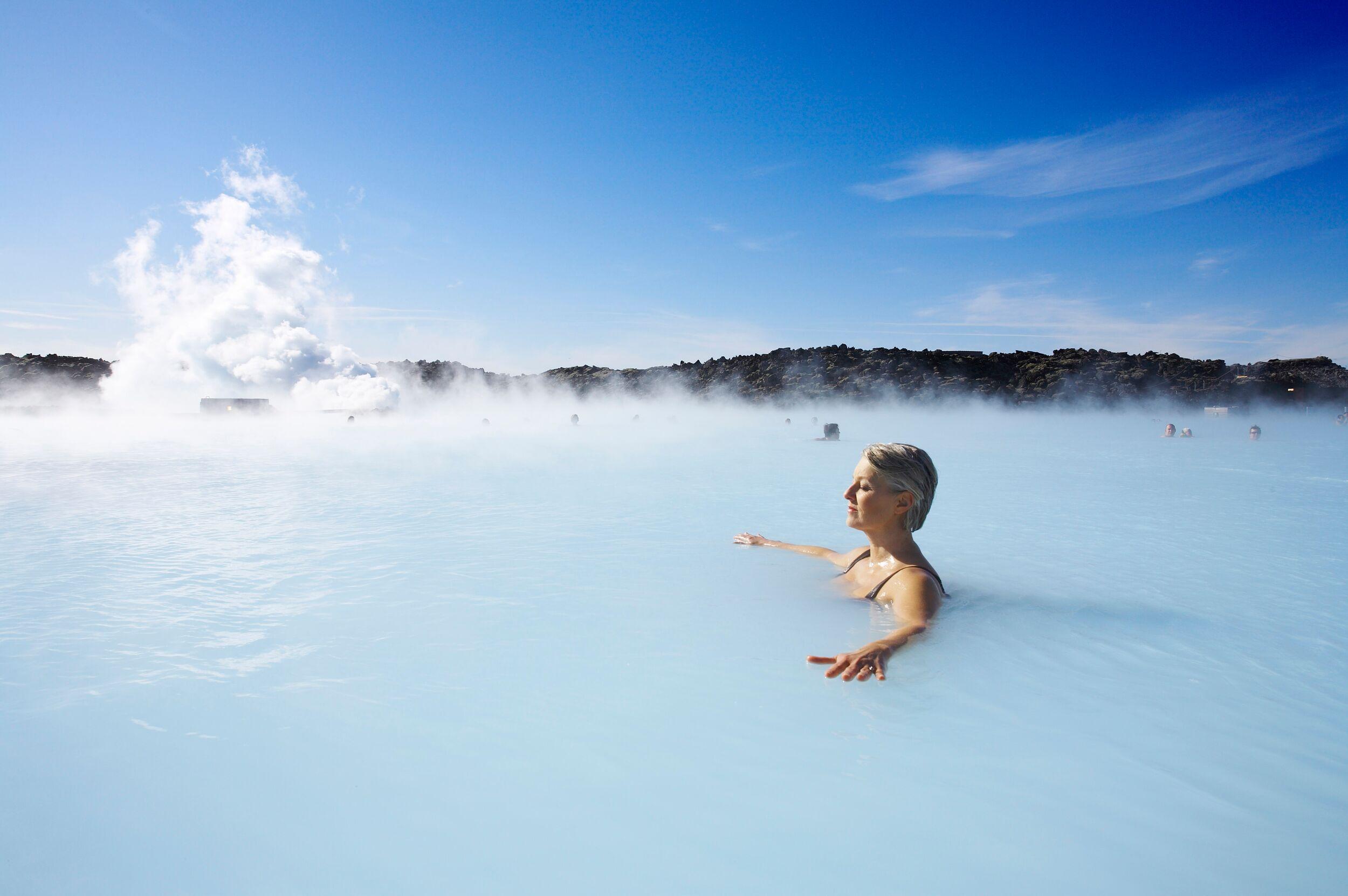
- Best seller
- Popular
Blue Lagoon & Northern Lights
Enjoy a perfect winter day in Iceland! Experience the best of Iceland with this package of two of the island’s most popular tours in one day! Soak in the milky blue healing water of the Blue Lagoon, which is one of Iceland's most famous tourist attractions and is considered by many to be a once-in-a-lifetime experience and an unmissable part of a visit to Iceland. After your return to Reykjavík, a guide will lead you on a search for the elusive northern lights! Watching the lights dance and flicker in the sky, changing shape and colour, is incredible. Prepare to be dazzled!
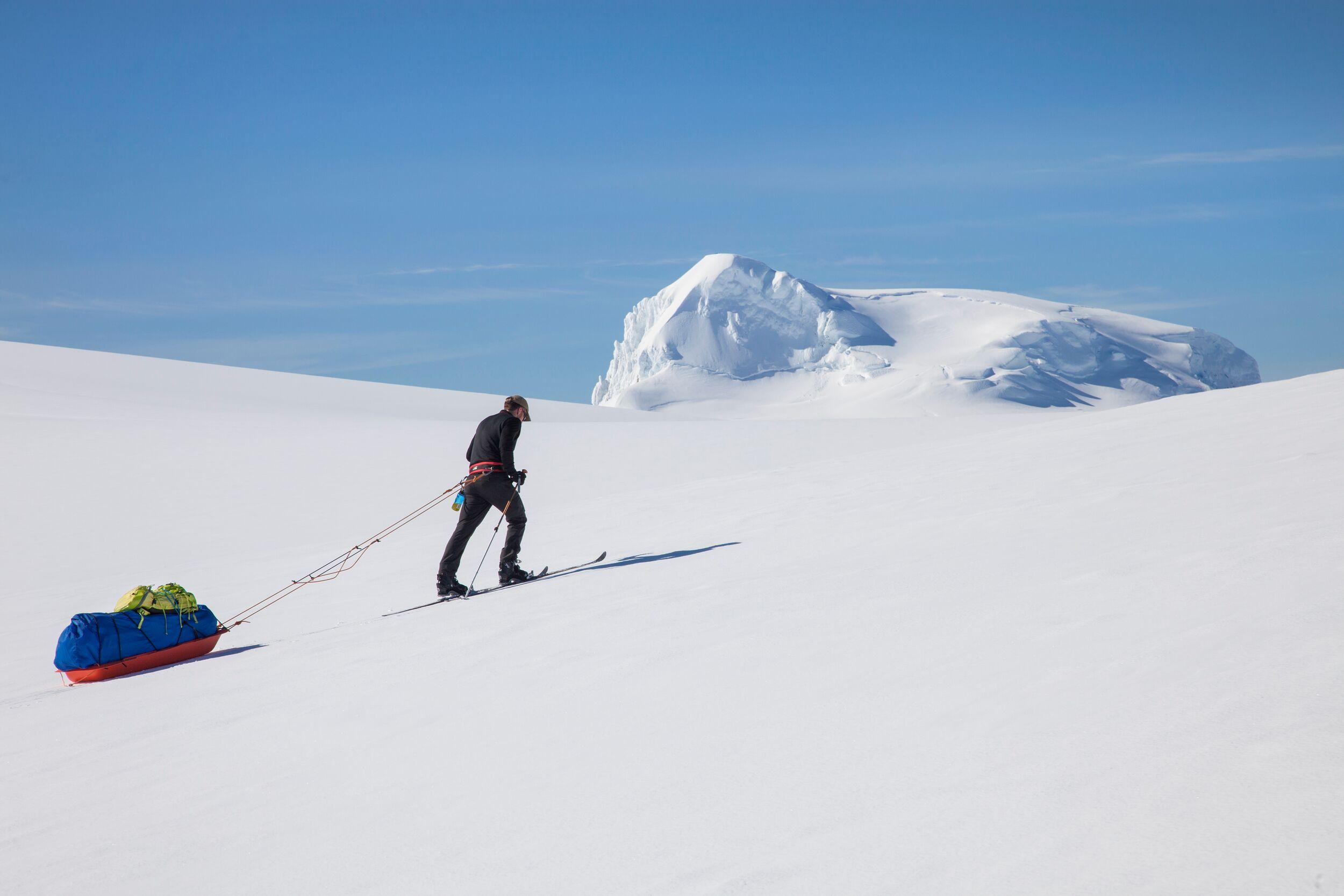
Vatnajökull Glacier Expedition
Cross the largest glacier in Europe during this perfect combination of adventure, stunning nature and physical challenge. This is a dream tour for outdoor enthusiasts! Crossing the mighty Vatnajökull ice cap should be on the list for every ambitious adventurer.




